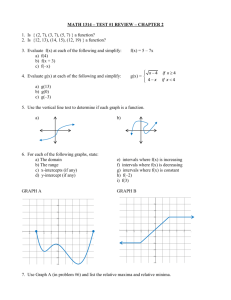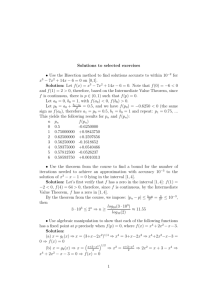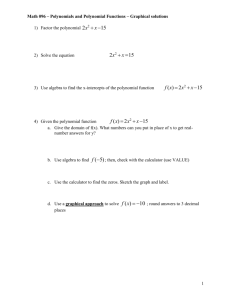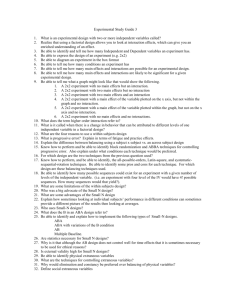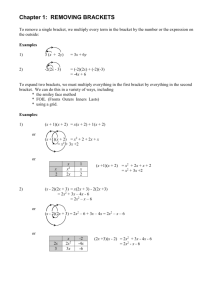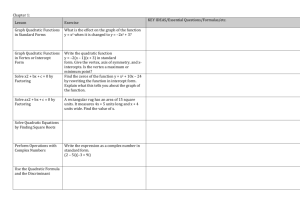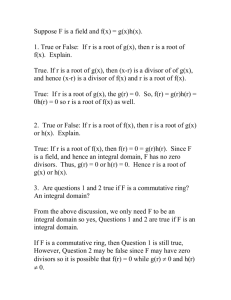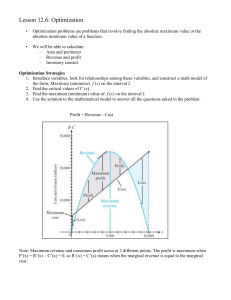MATH 1314 – TEST #2 REVIEW – CHAPTER 3 1. Find the vertex, x
advertisement
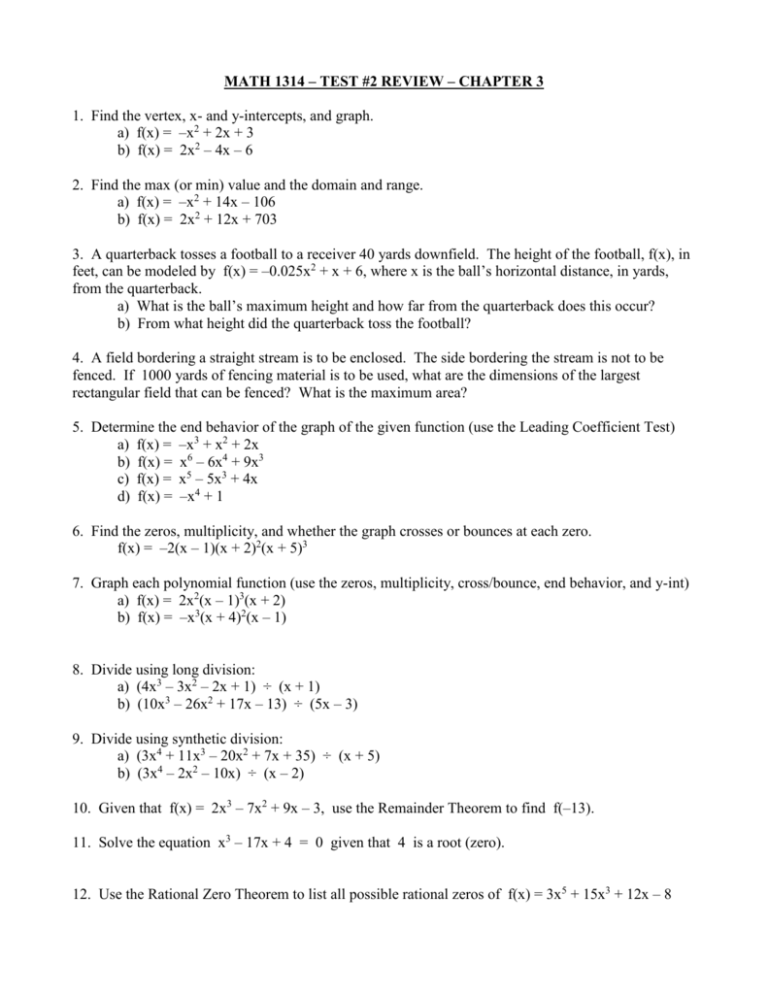
MATH 1314 – TEST #2 REVIEW – CHAPTER 3 1. Find the vertex, x- and y-intercepts, and graph. a) f(x) = –x2 + 2x + 3 b) f(x) = 2x2 – 4x – 6 2. Find the max (or min) value and the domain and range. a) f(x) = –x2 + 14x – 106 b) f(x) = 2x2 + 12x + 703 3. A quarterback tosses a football to a receiver 40 yards downfield. The height of the football, f(x), in feet, can be modeled by f(x) = –0.025x2 + x + 6, where x is the ball’s horizontal distance, in yards, from the quarterback. a) What is the ball’s maximum height and how far from the quarterback does this occur? b) From what height did the quarterback toss the football? 4. A field bordering a straight stream is to be enclosed. The side bordering the stream is not to be fenced. If 1000 yards of fencing material is to be used, what are the dimensions of the largest rectangular field that can be fenced? What is the maximum area? 5. Determine the end behavior of the graph of the given function (use the Leading Coefficient Test) a) f(x) = –x3 + x2 + 2x b) f(x) = x6 – 6x4 + 9x3 c) f(x) = x5 – 5x3 + 4x d) f(x) = –x4 + 1 6. Find the zeros, multiplicity, and whether the graph crosses or bounces at each zero. f(x) = –2(x – 1)(x + 2)2(x + 5)3 7. Graph each polynomial function (use the zeros, multiplicity, cross/bounce, end behavior, and y-int) a) f(x) = 2x2(x – 1)3(x + 2) b) f(x) = –x3(x + 4)2(x – 1) 8. Divide using long division: a) (4x3 – 3x2 – 2x + 1) ÷ (x + 1) b) (10x3 – 26x2 + 17x – 13) ÷ (5x – 3) 9. Divide using synthetic division: a) (3x4 + 11x3 – 20x2 + 7x + 35) ÷ (x + 5) b) (3x4 – 2x2 – 10x) ÷ (x – 2) 10. Given that f(x) = 2x3 – 7x2 + 9x – 3, use the Remainder Theorem to find f(–13). 11. Solve the equation x3 – 17x + 4 = 0 given that 4 is a root (zero). 12. Use the Rational Zero Theorem to list all possible rational zeros of f(x) = 3x5 + 15x3 + 12x – 8 13. Using the method learned in class (±p/q, graph, synthetic division, factors, solve), find all of the zeros for each of the following equations: a) b) c) d) f(x) = f(x) = f(x) = f(x) = 8x3 – 36x2 + 46x – 15 2x3 + 9x2 – 7x + 1 x4 – x3 – 7x2 + x + 6 4x4 + 7x2 – 2 14. Use transformations of f(x) = a) g(x) = 1 x or f(x) = 1 1 (x 2)2 1 x2 to graph each rational function: b) g(x) = 1 3 x 1 15. Find the vertical asymptotes, horizontal asymptotes, slant asymptote (if there is one), and graph. x2 2x 2x 4 a) f(x) = 2 b) f(x) = c) f(x) = x 9 x 3 x 1 16. Solve each inequality, graph the solution on a real number line, and write the answer in interval notation. a) (2x – 1)(x + 3) < 0 b) (2x + 1)(x + 4) ≥ 0 c) (x 1)(x 2) 0 x 1 d) x 3 0 x 4 Answers: 1. a) vertex: (1, 4) y-int: (0, 3) x-int: (–1, 0) & (3, 0) vertex: (1, –8) y-int: (0, –6) x-int: (–1, 0) & (3, 0) b) 2. , Domain: , a) max is (7, –57) Domain: b) min is (–3, 685) , 57 Range: 685, Range: 3. a) Max height is 16 feet. It occurs at 20 yards. b) 6 feet (let x = 0) 4. Dimensions: 250 yd × 500 yd; 5. a) b) c) d) Max Area: 125000 yd2 up on the left; down on the right up on the left; up on the right down on the left; up on the right down on the left; down on the right 6. Zero 1 -2 -5 7. Cross/Bounce C B C a) f(x) = 2x2(x – 1)3(x + 2) 8. Multiplicity 1 2 3 b) f(x) = –x3(x + 4)2(x – 1) a) Q: 4x2 – 7x + 5 b) Q: 2x2 – 4x + 1 R: –4 R: –10 9. p = 8 (factors are 1, 2, 4, 8) q = 3 (factors are 1, 3) a) Q: 3x3 – 4x2 + 7 R: 0 b) Q: 3x3 + 6x2 + 10x + 10 R: 20 10. –5697 11. x = 4, 2 5 12. 1 2 4 8 1, , 2, , 4, , 8, 3 3 3 3 13. a) x = 1 3 5 , , 2 2 2 c) x = 2, 1, 1, 3 b) x = 1 5 29 , 2 2 d) x = 1 1 , , i 2, i 2 2 2 14. a) left 2, down 1 b) right 1, up 3 15. a) VA: x = 3, x = –3 HA: y = 0 SA: none b) VA: x = –3 HA: y = 2 SA: none 15. continued… c) VA: x = –1 HA: none SA: y = x – 1 16. a) 3, 12 -3 b) ½ , 4 12 , -4 ½ c) 1,1 2, -1 1 2 d) 3,4 -3 4

